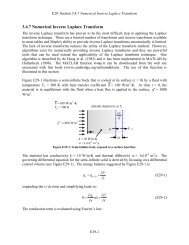5.3 Class Magnoliopsida – flowering plants - Cambridge University ...
5.3 Class Magnoliopsida – flowering plants - Cambridge University ...
5.3 Class Magnoliopsida – flowering plants - Cambridge University ...
You also want an ePaper? Increase the reach of your titles
YUMPU automatically turns print PDFs into web optimized ePapers that Google loves.
234 ORDERING THE PATHS OF DIVERSITY<br />
Figure 5.74. Palm<br />
inflorescences.<br />
Figure 5.75. Bromeliad<br />
inflorescence, showing the<br />
disticous arrangement of bracts<br />
and flowers common in the Poales.<br />
Commelinids<br />
arecales (palms)<br />
The Arecaceae palms are the most important group of monocot trees<br />
but, like other monocot trees, they are unbranched or only weakly<br />
branched and lack a vascular cambium (Figure <strong>5.3</strong>0). Rather, secondary<br />
growth occurs by the expansion, and occasional dichotomous<br />
splitting, of a large apical meristem. The leaves of palms are large and<br />
complex, often palmate or pinnately lobed, and highly folded. Their<br />
flowers are relatively simple, following a standard monocot pattern<br />
with parts in threes, but often they are grouped together in massive,<br />
profusely branched inflorescences. About six subfamilies have been<br />
distinguished based on the form of the leaf (fan or feather) and its<br />
folding (rib down -- induplicate, or rib up -- reduplicate).<br />
poales (grasses, sedges and rushes)<br />
The Poales dominate most ecosystems where the growth of trees is<br />
limited. The Typhaceae, Juncaceae and Cyperaceae are common dominants<br />
of semi-aquatic and water-logged conditions. In contrast the<br />
Poaceae dominate moist or dry habitats in many climates, everywhere<br />
tree growth is restricted for any reason. They tolerate fire and grazing,<br />
even mowing, regrowing rapidly after they have been damaged.<br />
Grasses have a diverse of photosynthetic mechanism; C4 photosynthesis<br />
is common and has evolved many times over, permitting them to<br />
grow rapidly in the tropics.<br />
The Xyridaceae have showy flowers. The Bromeliaceae have showiness,<br />
but it is mostly provided by colourful bracts. The bromeliads are<br />
very important epiphytes in the Americas as tank-<strong>plants</strong> or air-<strong>plants</strong>.<br />
Their flowers are relatively unspecialised, but commonly each flower<br />
is produced at the base of a brightly coloured bract. Most are epiphytic<br />
and show many adaptations for their epiphytic life-style such<br />
as water storage tissue or water-absorbing peltate scales. The air-<strong>plants</strong><br />
Tillandsia, including Spanish moss, are perhaps the most remarkable<br />
in their ability to absorb moisture from the air. Most of the ground<br />
bromeliads have adaptations for arid environments.
















